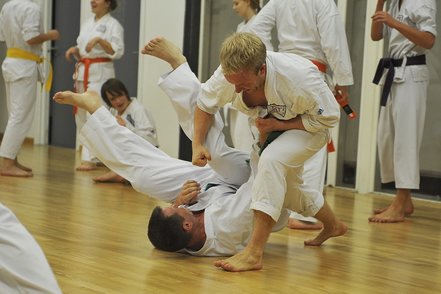 In traditional karate, we place great emphasis on the study and practice of kata, especially those particular to our styles. It is not unusual to do hundreds of repetitions of a kata during a period of intensive study. Unfortunately, usually the study and practice of kata ends there. It is limited to the chaining of kihon techniques in a given order without anything that differentiates it from any other kata. It is very common to see very experienced karateka do one kata after another without being able to observe the slightest difference in technical, energetic or structural characteristics between one kata and the next. In this article I want to present the areas of study and practice of kata that form the basis of the study in the Sekishin Karate Jutsu (SKJ) and at my Dojo, Ten Chi Jin Martial Arts Academy. JU Ju means soft, lacking in tension. In his book Hidden Karate, the true bunkai for the Heian Katas and Naihanchi, the teacher Gennosuke Higaki (of the Shotokan school) tells his first encounter with he who would become his Sensei, Shozan Kubota sensei *: "The first time I saw Kubota sensei, he showed me Heian Shodan. I knew he was a karate instructor, but I could not recognize the kata he was showing me as the kata Heian Shodan. It looked more like a form of Taichi than a karate kata. Me: "Is that taichi?" Sensei: "It's karate" Me: "What is the name of that kata?" Sensei: "It's Heian Shodan" Me: "???? What is your style ??? " Sensei: "Shotokan, direct from Gichin Funakoshi" Me: "I also do Shotokan. Why is it so different from what you do? " Sensei: "Because what you do is simple gymnastics" Me: “What?" Sensei: "Can you use your kata when you do kumite?" Me: “No, I can’t" Sensei: "So, what you do is a simple gym exercise" Me: "Sensei, can you use your kata in kumite practice?" Sensei: Let's see ... attack me! " Me: "Pow! Ouch !!!! ....... " * (Transcribed from memory) This small excerpt from Gennosuke Higaki sensei's book is symptomatic of what we have lost along the way. It is the first time that I find a written reference to something that we at our Dojo have been doing for many years, but never having received external validation as a recognized method of study and practice within karate. It is vital for our school to study the katas in their Ju form. Why? Because the slow execution of kata allows us to become aware of, and deepen our control over the structural bases necessary for movement and the execution of karate techniques. Simultaneously our awareness and control over the different energetic sources of the human body, its relation to the skeletal foundation and its interrelation at the moment of generating and transmitting energy. All this is possible only if the kata is studied and practiced slowly. The speed of execution is dictated by the ability of our minds to observe, control and manage all these concepts simultaneously. BU Bu of bushi, warrior. This form of kata practice refers to a form of practice in which the core is not technical excellence or precision. The central concept of this form of kata practice is the full expression of mind, body and technique within the technical context of kata. When deepening in kata’s Bu form, what is being done is to practice kata, as if we were fighting. Emulating combat from a technical, physical and psychological perspective in terms of explosiveness, speed and aggressiveness. This way of training is vital, to recognize the practical viability of karate kihon and dissipate illusions or mirages about our technical, physical and psychological reality. System Kata is a very deep source of information. But to access it, it is necessary to break down the kata, open it and study it from different perspectives. 1. Strategy: What is the basic combat strategy postulated in kata? Evasion, invasion, obstruction, countering, etc. 2. Tactics: Once we have identified the basic strategic postulate of kata, it is necessary to study and identify the tactical approaches that kata proposes to achieve its strategic objectives: Grappling, percussion, dislocation, etc. 3. This brings us naturally to the Bunkai: The bunkai involves an analysis of the tactical and technical approaches of the kata and its possible application in a physical confrontation. 4. Principles: Every technique that appears in a kata, functions as a matrix and model for all possible forms and variations of that technique. In addition, by extension kata contains the anatomical, structural and energetic principles necessary for the correct execution of the included techniques. It is necessary to identify, isolate and extract these principles to include their study and practice separately, outside the context of kata, whether in the form of kihon, kumite or any of the intermediates, be it makiwara, bag work, renrakuwaza, etc. Soon I will make a series of articles where we will look at some of these elements more closely. Until then to follow the DO, this hard, arduous and wonderful way of Karate Do.
1 Comment
|
AuthorJorge F. Garibaldi Archives
December 2020
Categories |

 RSS Feed
RSS Feed